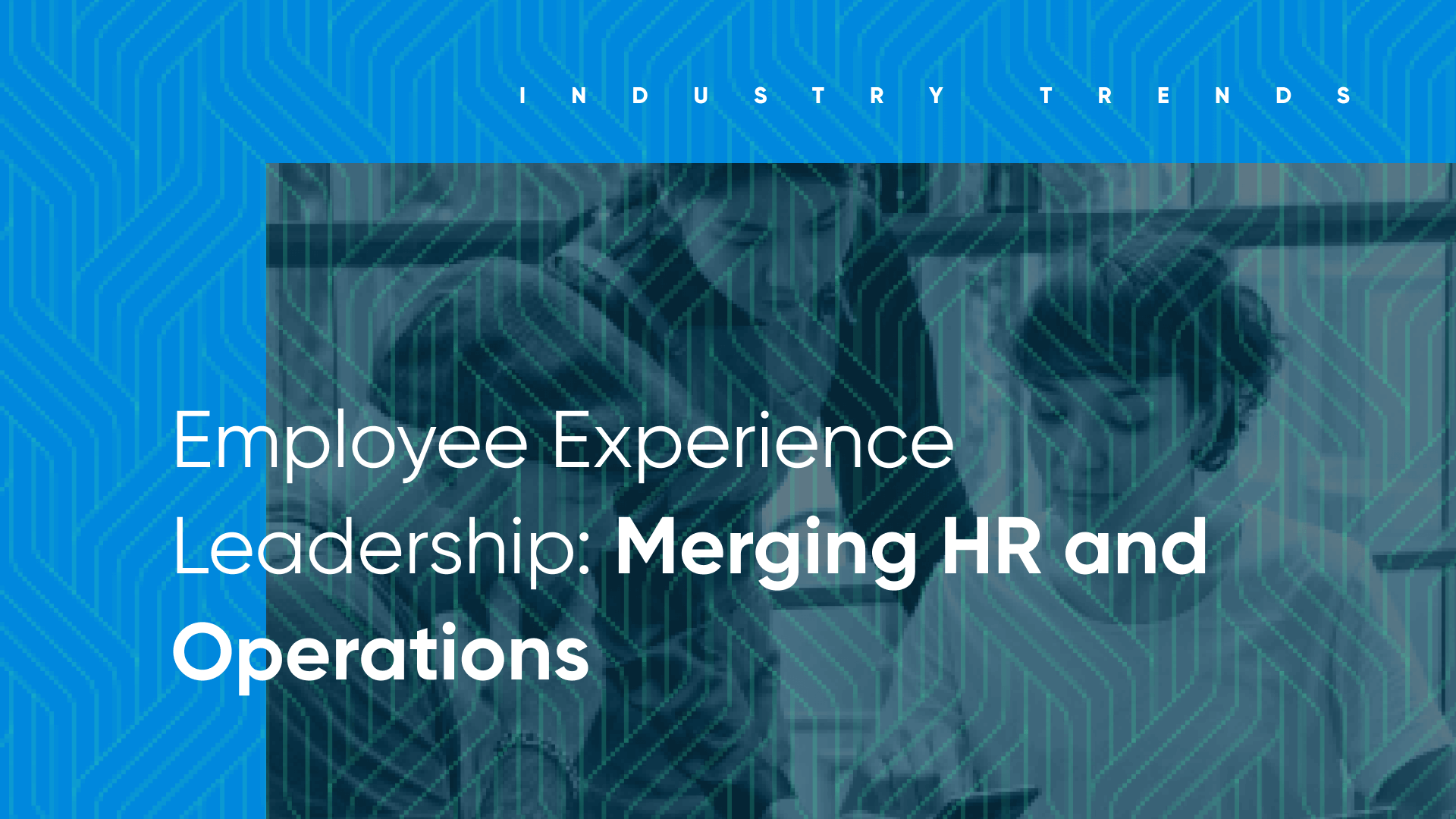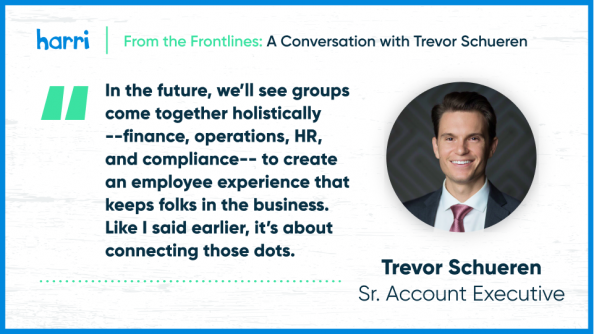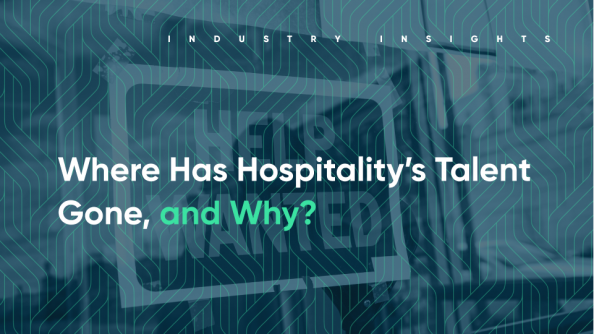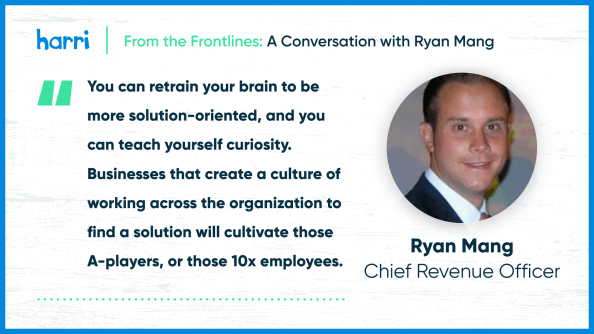Employee Experience Leadership: Merging HR and Operations

- By Harri Insider Team | March 8, 2021
Anyone who has worked in hospitality knows that the guest experience takes priority over all else. It all boils down to the famous saying, “the customer is always right.”
Hospitality is laser-focused on creating the best possible customer experience at any cost. We are in the business of service, after all, and anyone knows that one bad review can be detrimental to business.
To that end, chances are high that your team’s turnover rates are high. It’s something that we, as an industry, have come to expect. Jobs are typically seen as temporary, and we’ll work our employees to the bone to ensure happy customers no matter the circumstances.
But times are changing. And while satisfying customers certainly is an important component of hospitality, we believe the industry has been incorrectly approaching the guest experience. Starbucks and Chipotle are known for their commitment to employee career progression, among many other support initiatives. It makes industry talent view them as desirable workplaces; nobody can doubt that either brand is lacking on the sales front.
Consider the ways your brand creates a great customer experience. Is it through your products, dining atmosphere, values, or guest service? All of these are probably true to some extent or another, but a vital component is missing: the employee experience.
Operational success demands us to view employees as long-term assets. When your employees perform well and are positioned for success, you’ll see that turn out in the form of happier teams and increased retention — both of which translate into a better guest experience.
Hospitality operators that want to move the needle need to be employee experience leaders and must create team-driven workplaces that naturally attract top talent.
Shifting focus from guest experience to employee experience
The employee experience is somewhat of a trend in hospitality and the workforce as a whole. Thanks to COVID-19, workplace safety, wellness, and morale have been at the forefront of employee-focused initiatives.
But it’s easy to separate the authentic workplace champions from those looking for a press opportunity. Texas Roadhouse is an excellent example of a company going the extra mile to ensure a great customer experience — and saw a boosted bottom line as a result.
Throughout the pandemic, the brand pushed out several people-centric initiatives purely designed to create a supportive workplace and empower employees to perform their best. Texas Roadhouse reported consistently positive monthly revenue without laying off employees.
How can your company develop meaningful employee experience leadership to attract and retain top talent in hospitality?
High turnover rates and the endless search for quality talent
Hospitality’s growing talent crisis means employees and candidates can be picky about their jobs. Amidst high turnover rates, many businesses struggle with finding talent that fit’s their service and cultural needs.
Maybe they’re looking in the wrong places, or maybe they’re not appealing to the right audiences.
Today’s hospitality workers are looking for:
- Scheduling and workplace flexibility
- Growth opportunities within the company
- An employer whose values align with their own
- Competitive wages
- Benefits that span beyond the workplace
All of these points tie back to the employee experience in one way or another.
It might sound like a lot, but there are a number of factors that you can control with employee-focused tools like all-in-one HCM platforms. But the making of a great employee experience doesn’t come with the implementation of a single tool. Operators and managers that weave together tech enablement and employee engagement will be better positioned to drive success from the bottom up.
Putting the “human” back in HR
Hospitality managers rarely invest in employees at a level that engages and excites them, and part of this is thanks to the industry’s talent crisis.
Talent moves quickly in hospitality, and hiring managers must move quickly in order to grow their teams or fill in skill gaps. Thanks to COVID-19, teams are expected to do more with less. Employees are losing the ability to effectively manage multiple tasks at once, which means businesses will need to seek more quality talent.
Yet hiring should never be approached without a plan for sustainability. The employee experience tends to suffer when managers view them as replaceable assets rather than people.
Combine this with a rocky hiring process, and you have yourself a recipe for poor business operations and increased employee turnover. Failure to adapt means the cycle will continuously repeat itself.
How can hiring managers break this cycle?
The first step should be to create an accessible application process. Job applications must be mobile-friendly, take less than 5-minutes to complete, and be readily available on multiple platforms. Applications should be customized by position or location, and should contain knockout questions to automatically disqualify candidates that won’t be good fits.
From there, you need a way to effectively sort, track, and engage with candidate applications coming in from various sources. If your ATS doesn’t give you an easy way to manage hundreds of incoming applications, you’ll fall behind on following up on those great fits.
And when you’re ready to hire? A digital, labor-compliant onboarding process should streamline the process of filling and collecting new hire paperwork. Anything from tax forms to good faith hour estimates should be readily available to both managers and new team members.
The ratio of HR members to employees and candidates is never favorable, so executing these processes and more can seem like an extremely daunting process. However, all of this and more can be completed with an integrated pre-hiring system that connects the dots between all HCM processes.
The employee experience is felt even before a candidate begins working in your organization. Using technology to reduce friction and imbue culture sets an early tone of employee investment — and improves retention as a result. Below we’ll cover ways to continue to build upon the employee experience in your team’s day-to-day.
Scheduling: it’s more than just labor allotment
For managers, employee schedules of today represent far more than a way to organize and deploy labor. They’re a tool to retain talent and cater to a better employee experience.
Why is that?
Service-based employees plan their lives around their schedule. It dictates how they arrange childcare, commuting schedules, budget planning, the ability to work a second job, and so much more.
When employees receive schedules that don’t work with their needs, or worse, are subject to dramatic last-minute changes, their satisfaction with your business significantly declines.
That’s exactly why predictive scheduling laws like Fair Workweek have been gaining popularity across the nation. When employees receive consistent, predictable schedules, they’re more likely to be satisfied with their job.
That satisfaction translates into two outcomes: better work performance and an increased willingness to stay in their job, or even better, continue to grow in their role. Both of which clearly convert into driving factors behind a great customer experience and operational success.
The most desirable hospitality businesses to work in will provide maximum scheduling flexibility, although the real challenge is finding the middle ground in creating schedules that satisfy your employees while also ensuring labor efficiency
Intelligent scheduling that integrates with all HCM processes is integral to striking that balance. When managers have the ability to auto-populate schedules based on predicted labor demand, team skills, employee availability, and scheduling preferences, creating balanced schedules is entirely possible. And it relieves strain off your managers who have nowhere near the time to account for all of those factors when creating team schedules.
We all know that hospitality never stops moving. Other scheduling must-haves, like employee-driven shift swaps, schedule change notifications, and mobile communications between management and unit-level employees ensure operational success without burdening your team with unnecessary administrative tasks.
A little goes a long way. When you empower managers to make smarter scheduling decisions while also providing service-level employees a work environment that fits their preferences, everybody wins — including your guests, who benefit from top-notch service.
Consistent touchpoints are key
COVID-19 has forced service-based employees to work long hours while being exposed to customers in uncertain and rapidly changing conditions. As such, workplaces that have put an emphasis on staff wellness and morale are seen as champions in the space and have benefitted from outstanding employee-driven pandemic operations.
Trust is a huge part of the employee experience, and as such, hospitality businesses that have utilized internal communications platforms during uncertain periods have benefitted from stronger team transparency and retention.
We’ve seen the reverse end of this when COVID first hit and now as vaccine mandates are at the forefront of restaurant news. When employees are left out of the loop they become anxious, especially during uncertain times. Lack of transparency creates questions, and those questions turn into rumors.
Before you know it, employees are stressed about potential non-issues and start looking for opportunities where the grass is greener.
But a solid employee communications platform can prevent dissatisfaction snowballs while ensuring a consistently transparent workplace. Manager communication blasts, clock-in messages, and Facebook-style news feeds enable managers to send vital, timely messages to employees. Changing COVID-19 policies? Your entire team can be notified within minutes and have a digital record to reference in the future.
Interpersonal communications are equally as important to the employee experience. Team group chats or private communication channels give employees a confidential way to voice concerns inside and outside of the organization.
And if that communications platform is part of an all-in-one HCM solution, employees are immediately linked to relevant team members based on their position, scheduling needs, or day-to-day responsibilities.
Consistent touchpoints extend beyond direct communications. Managers must be able to predict dissatisfaction and take proactive steps towards ensuring a positive work environment.
While a real-time, cross-functional data analytics platform is an invaluable tool in boosting business performance, it can also be used to gauge the employee experience. Operators must have the ability to look for the stories within the data.
Is an employee consistently showing up late? Have they been skipping breaks? Are their sales down consistently down? These can be indicators that they’re overwhelmed, not given tools to succeed, or are possibly dealing with problems outside of the workplace.
Hospitality was a difficult industry even before COVID-19 — observing patterns in employee performance can help managers identify potential stressors both inside and outside the workplace. Working to alleviate the stressors, or at least providing additional support where possible, makes all the difference in the employee experience.
And if we’re talking about work performance, HCM-related data forecasting and analytics can be used to optimize operational processes on a daily, weekly, monthly, and yearly basis. Anything from employee shift swaps and POS clock-ins to the very act of smart schedule creation can be improved based on efficiency and output metrics, thus setting your teams up for long-term success.
An all-in-one HCM platform with built-in analytics can connect the dots between employee schedules, time and attendance, sales performance, payroll, and more to find these platforms, and others.
Brace yourself for the boom
As the employee experience continues to take the spotlight in hospitality, brands that step will be seen at the forefront of happier employees, smarter hiring, and satisfied guests. Tech-based initiatives to inform and empower employees will be at the forefront of employee experience leadership, and we’ll see an increasing number of brands turn to digital transformation.
When an all-in-one HCM platform streamlines HR and operations, team members of all levels are positioned to succeed. Learn how Harri helps hospitality to achieve operational success by enabling them to focus on their most important asset: their people.




















